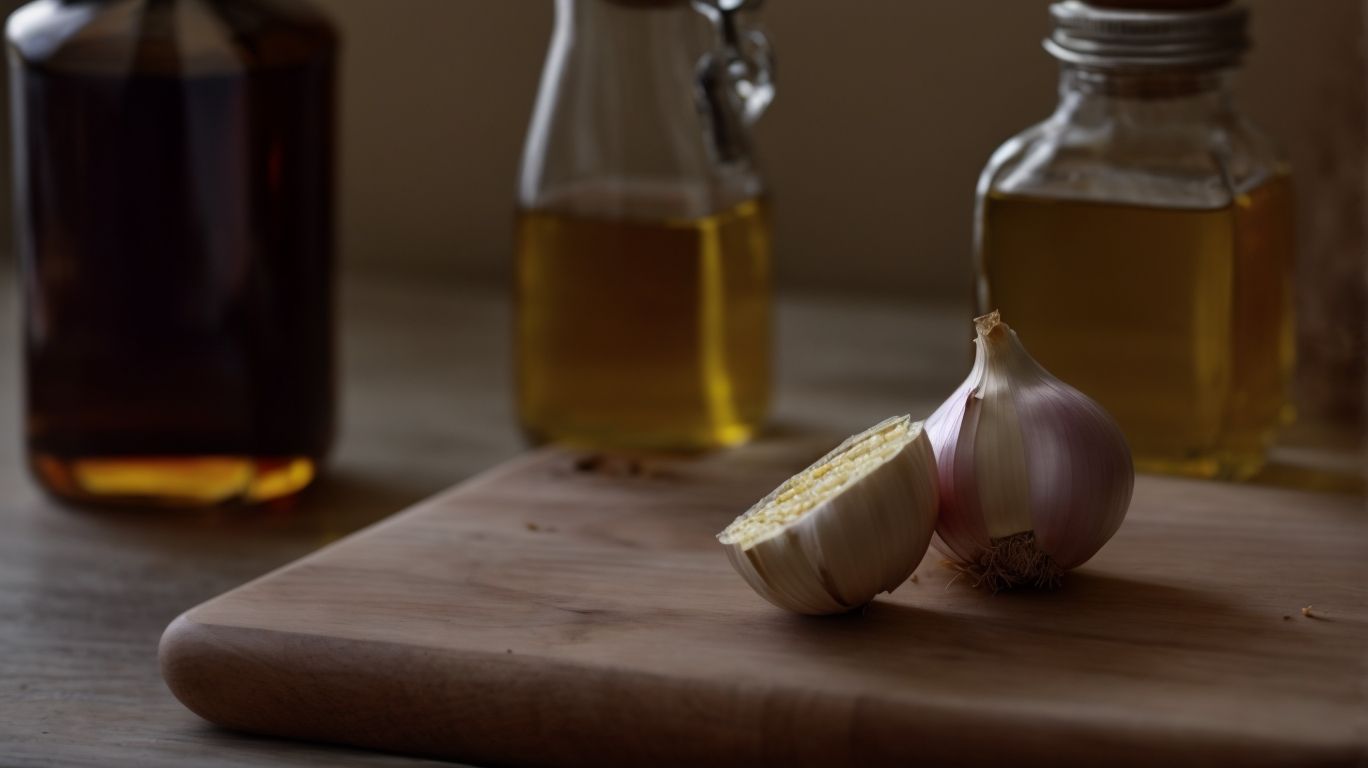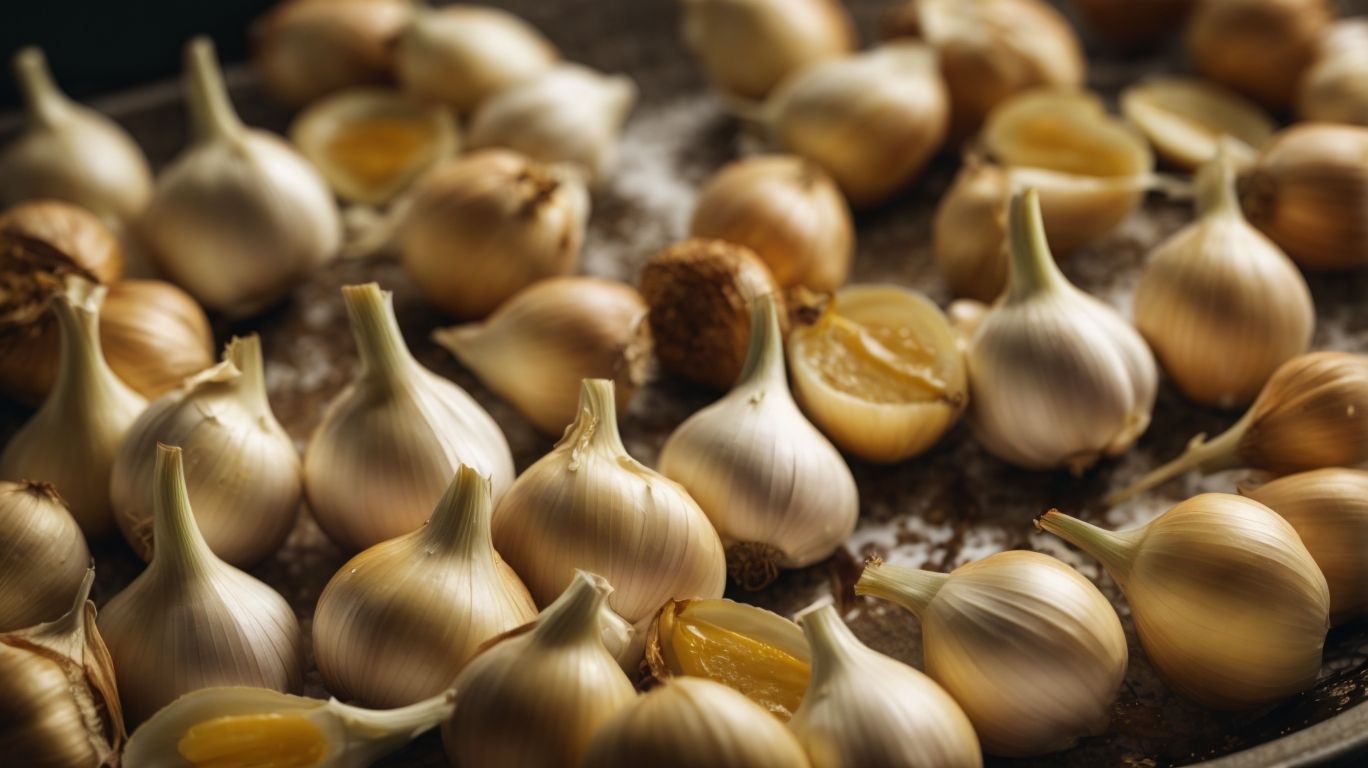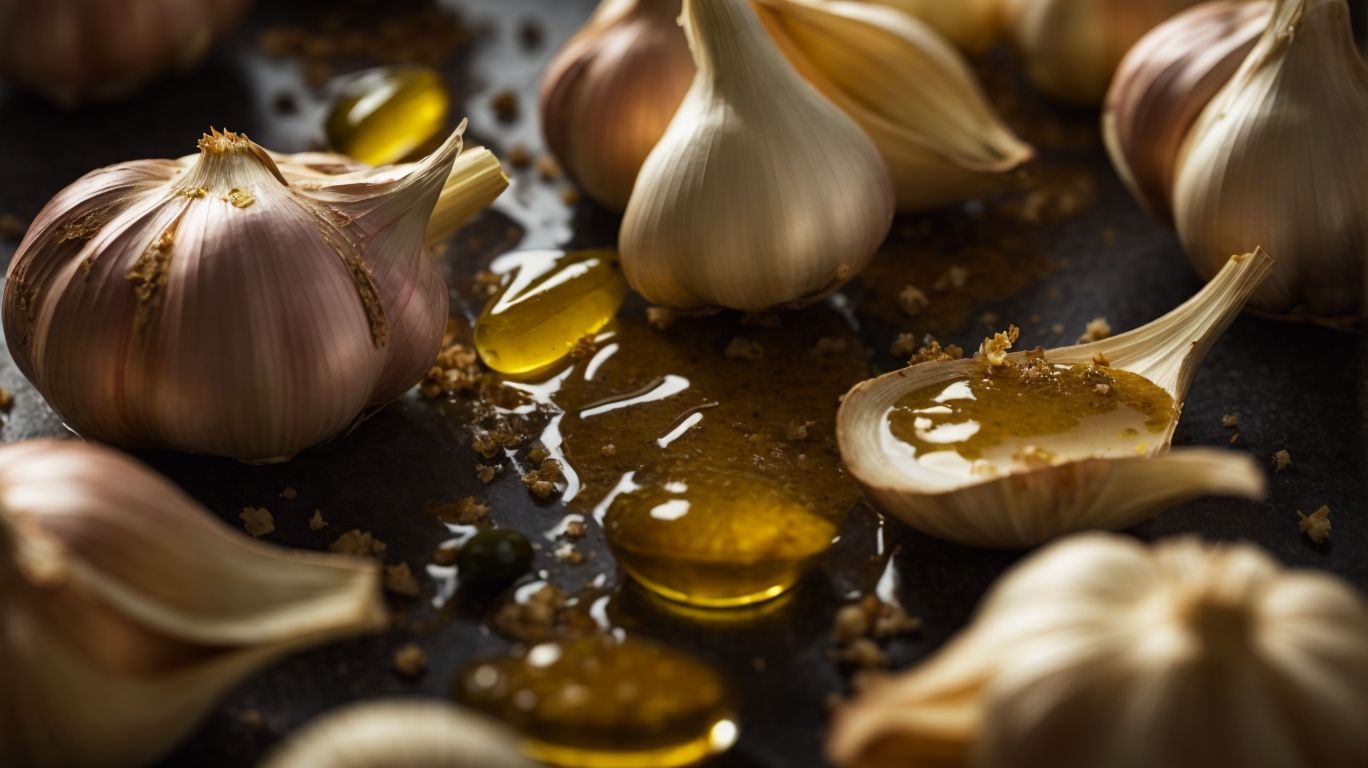How to Bake Garlic With Olive Oil?
Are you looking to elevate your culinary game with a simple yet flavorful addition to your dishes?
Try baking garlic with olive oil. We will explore the health benefits of olive oil, how to prepare garlic for baking, the different types of olive oil to use, and various methods for baking garlic with olive oil.
Whether you’re a seasoned chef or a kitchen novice, these tips and tricks will help you create delicious dishes that will impress your guests.
Grab your apron and let’s get cooking!
Key Takeaways:
Why Use Olive Oil for Baking Garlic?

Credits: Poormet.Com – Eugene Robinson
Utilizing olive oil in the process of baking garlic results in enhanced flavors and textures, elevating the overall culinary experience.
When olive oil blends with garlic in the oven, it not only infuses the cloves with its rich, fruity notes but also helps in achieving that perfect balance of crispiness and tenderness. The gentle heat of the baking process allows the garlic to caramelize, intensifying its sweetness while mellowing out any harshness.
The use of olive oil in this culinary technique enlivens the entire kitchen with a delightful aroma that wafts through the air, preparing taste buds for the gastronomic delight soon to come.
What are the Health Benefits of Olive Oil?
The health benefits of olive oil encompass a wide range of advantages, including promoting heart health, reducing inflammation, and providing essential antioxidants.
Olive oil is rich in monounsaturated fats, which have been shown to lower the risk of heart disease by reducing bad cholesterol levels and improving overall heart health. Its anti-inflammatory properties can help alleviate symptoms of conditions such as arthritis.
The high antioxidant content in olive oil helps protect cells from damage caused by free radicals, thus playing a crucial role in reducing the risk of chronic diseases, including cancer, cognitive decline, and aging-related conditions.
How to Prepare Garlic for Baking?
Before embarking on the baking process, it is crucial to properly prepare the garlic by peeling, smashing, or slicing the cloves to achieve the desired texture and flavor profile.
When peeling garlic, start by separating the cloves from the bulb. Place a clove on a cutting board, lay the flat side of a knife on top, and gently press down with your palm to loosen the skin, making it easier to peel. If you prefer smashed garlic, use the flat side of the knife to press down firmly on a clove until it bursts open. For sliced garlic, simply trim both ends off a clove, then make thin or thick slices as needed for your recipe.
Peeling Garlic Cloves
Peeling garlic cloves is a fundamental step in the baking process, ensuring easy access to the aromatic essence within each clove for maximum flavor infusion.
Garlic, renowned for its pungent and unique taste profile, adds depth and richness to a myriad of dishes. To peel garlic cloves efficiently, place the clove on a cutting board and press down with the flat side of a knife till it slightly cracks. Removing the skin becomes a breeze once the clove is crushed. Alternatively, you can also try shaking the cloves vigorously in a sealed container to loosen the skins. Such techniques not only simplify the peeling process but also enable you to fully unlock the potent flavors concealed within each garlic clove.
Smashing Garlic Cloves
Smashing garlic cloves aids in releasing their aromatic oils and intensifying the flavor profile, creating a more robust garlic essence for baking applications.
When you smash garlic cloves, you break down the cell walls within the clove, helping to release enzymes that react to produce the characteristic pungent aroma and flavors. This technique alters the garlic’s taste, making it more robust and intense, perfect for dishes where garlic plays a leading role. By smashing the cloves instead of simply mincing or slicing them, you ensure that the aromatic oils are dispersed more evenly, infusing your dishes with a harmonious garlic essence.
Slicing Garlic Cloves
Slicing garlic cloves into thin, uniform pieces allows for even distribution of flavor throughout the dish, ensuring a consistent garlic presence in every bite.
Regarding preparing garlic for baking, the technique of slicing is crucial for achieving the desired taste and aroma. Ideally, aim for thin slices that are as equal in size as possible to ensure that the garlic cooks evenly. Uniformity in slicing also helps in preventing some pieces from burning while others remain undercooked, resulting in a perfectly balanced dish.
To slice garlic cloves effectively, start by trimming off the tips and peeling the outer skin. Once exposed, use a sharp knife to make precise, thin slices. Precision is key here to control the intensity of garlic flavor; thinner slices release more flavor compared to thicker ones.
What Type of Olive Oil to Use for Baking Garlic?
Selecting the appropriate type of olive oil is crucial for baking garlic, with options ranging from extra virgin, pure, to light olive oil, each offering unique flavors and characteristics.
Extra virgin olive oil is the highest quality and most flavorful option, extracted from the first cold pressing of olives, making it perfect for enhancing the taste of roasted garlic cloves.
Pure olive oil, a blend of refined and virgin olive oil, provides a milder flavor ideal for baking garlic in dishes where the oil flavor shouldn’t overpower.
Light olive oil, with a more neutral taste and higher smoke point, is suitable for high heat baking methods to prevent the garlic from burning or becoming bitter.
Extra Virgin Olive Oil
Extra virgin olive oil is a premium choice for baking garlic, known for its robust flavor, low acidity, and high nutritional value, enhancing the overall taste profile of the dish.
One of the key distinguishing features of extra virgin olive oil is its rich and fruity flavor, which can vary depending on the region where the olives are grown and the extraction process. It offers a perfect balance of fruity, peppery, and slightly bitter notes that work harmoniously with the pungent taste of garlic, creating a depth of complexity in the dish.
Moreover, extra virgin olive oil is celebrated for its health properties, being a great source of monounsaturated fats and antioxidants like vitamin E. These components not only contribute to heart health but also provide anti-inflammatory benefits, making it a wholesome choice for cooking and baking.
When used in baking garlic, the oil’s heat tolerance and smoke point are ideal for roasting the cloves to perfection without burning them, preserving their natural sweetness and enhancing the overall flavor. It also helps in achieving a crispy, golden brown exterior while keeping the insides soft and flavorful.
Pure Olive Oil
Pure olive oil is a versatile option for baking garlic, offering a mild flavor profile and high smoke point, making it suitable for various culinary applications.
Olive oil, especially the pure variant, stands out in the kitchen due to its ability to enhance the natural flavors of ingredients like garlic without overpowering them. Its mild taste is perfect for infusing dishes with subtle hints of fruitiness. The high smoke point of olive oil makes it ideal for cooking at higher temperatures, giving garlic a crispy texture without burning it. Whether you’re roasting garlic cloves to spread on crusty bread or incorporating them into savory dishes, pure olive oil adds a layer of richness and depth of flavor.
Light Olive Oil
Light olive oil is a subtle option for baking garlic, with a neutral taste and higher smoke point, ideal for preserving the delicate flavors of the dish without overpowering other ingredients.
When used in baking, light olive oil adds a hint of fruitiness and a mild aroma to dishes, enhancing the overall flavor profile. Its versatility shines especially in high-heat applications such as roasting garlic, where it maintains its integrity without breaking down. This makes it a reliable choice for achieving that perfect balance of flavor and texture. Its compatibility with delicate ingredients, such as herbs and spices, allows it to blend seamlessly, ensuring a harmonious blend of flavors in your culinary creations.
How to Bake Garlic with Olive Oil?
Baking garlic with olive oil involves a simple yet rewarding process of roasting whole garlic bulbs, cloves, or infusing olive oil with garlic for diverse culinary applications.
When roasting whole garlic bulbs, start by preheating your oven to 400°F (200°C). Slice off the top of the bulb to expose the cloves slightly. Place the bulb on a piece of foil, drizzle olive oil over the exposed cloves, and wrap it tightly. Roast in the oven for about 30-40 minutes until the cloves are soft and caramelized.
For roasting individual cloves, peel the cloves and place them on a baking sheet. Drizzle with olive oil, sprinkle with salt and pepper, and toss to coat evenly. Bake in the preheated oven at 400°F (200°C) for 15-20 minutes until they turn golden brown.
To make garlic-infused oil, gently heat olive oil in a saucepan over low heat. Add peeled garlic cloves and simmer for 15-20 minutes. Remove from heat and let it cool before straining the oil into a clean container for storage.
Roasting Whole Garlic Bulbs
Roasting whole garlic bulbs is a transformative process that yields soft, caramelized cloves with a mellow flavor, perfect for spreading on bread or incorporating into various dishes.
When roasting whole garlic bulbs, the cloves are enveloped in their own skins, protecting them from direct heat. This allows them to slowly caramelize, turning sweet and creamy as they cook. The caramelization process not only enhances the natural sweetness of the garlic but also softens the sharpness, resulting in a rich and complex flavor profile.
Once roasted, the cloves can be easily squeezed out of their papery skins, ready to be mashed into dips, sauces, or added to soups and stews for a depth of flavor. The versatility of roasted garlic extends to being spread on crusty bread, tossed into salads, or even used as a topping for pizza or pasta dishes.
Roasting Garlic Cloves
Roasting garlic cloves intensifies their flavors and softens their texture, creating a versatile ingredient for pasta dishes, spreads, or vegetable accompaniments.
When garlic cloves are roasted, the sharpness of their raw flavor mellows into a sweet, nutty taste, adding a delightful complexity to any dish they are incorporated into. The process of roasting breaks down the pungent compounds present in raw garlic, resulting in a more subtle and aromatic flavor profile. The texture of the garlic cloves transforms during roasting, turning creamy and spreadable, making them perfect for blending into sauces or dips. This gentle cooking method also infuses the garlic with a rich, caramelized essence, enhancing the overall depth of dishes.
Making Garlic Infused Olive Oil
Creating garlic-infused olive oil involves gently heating olive oil with garlic cloves to impart a rich, aromatic essence, enhancing the oil’s flavor for culinary applications.
Infusing olive oil with garlic is a simple yet transformative process. Begin by heating the olive oil in a saucepan over low heat, being careful not to let it smoke.
Next, add peeled garlic cloves to the warm oil, allowing them to infuse for about 20-30 minutes. The heat gently extracts the garlic’s flavors, creating a harmonious blend with the oil.
This infused oil can add depth to salad dressings, drizzled on roasted vegetables, or used to sauté meats and seafood.
What to Serve Baked Garlic with Olive Oil?
Serving baked garlic with olive oil complements a variety of dishes, including garlic bread, pasta creations, and roasted vegetable medleys, enhancing the flavors and textures of each preparation.
When garlic cloves are baked with a drizzle of olive oil, they undergo a magical transformation, turning soft, sweet, and irresistibly aromatic. This dynamic duo not only adds depth and richness but also brings a subtle nuttiness to the dishes, creating a symphony of flavors. Imagine warm, crusty garlic bread with the mellow notes of olive oil or a bowl of al dente pasta coated in a garlic-infused olive oil sauce. Roasted veggies glistening with the golden sheen of olive oil can truly elevate any meal.
Garlic Bread
Garlic bread infused with baked garlic and olive oil offers a delightful combination of savory flavors, crispy textures, and aromatic essences, making it a popular accompaniment to meals or a standalone snack.
The process of creating this delectable dish involves roasting garlic bulbs until they turn soft and fragrant, blending them into a smooth paste with virgin olive oil, then spreading it generously over slices of crusty bread. The flavors of the garlic deepen during the baking process, infusing the bread with a rich, earthy taste. The olive oil adds a subtle fruity note while keeping the bread moist inside with a crispy crust.
As the garlic bread bakes, the aroma of roasted garlic wafts through the kitchen, tantalizing the senses and building anticipation. Once ready, the bread emerges golden-brown and irresistible, the perfect balance of garlicky goodness and olive oil richness.
Pasta Dishes
Incorporating baked garlic and olive oil into pasta dishes adds depth of flavor, richness, and a savory undertone to the culinary creation, enhancing the overall taste profile of the pasta.
When baked garlic mingles with the pasta, it imparts a subtle sweetness and a mellow garlic flavor, creating a harmonious blend with the richness of olive oil. This combination not only elevates the taste but also adds a fragrant aroma that entices the senses. The garlic becomes tender and caramelized through the baking process, infusing each strand of pasta with its irresistible essence.
The olive oil acts as a silky carrier, coating the pasta evenly and contributing a luxurious mouthfeel. Its fruity notes complement the earthy warmth of the baked garlic, resulting in a balanced yet flavorful dish. Together, these ingredients create a symphony of flavors that dance on the taste buds, offering a culinary experience that is both comforting and indulgent.
Roasted Vegetables
Pairing baked garlic with olive oil in roasted vegetable dishes imparts a fragrant essence, caramelized notes, and a savory touch to the medley of vegetables, elevating the overall dining experience.
When the garlic bakes along with the olive oil, it transforms into a mellow and sweet addition that not only infuses its rich flavors into the vegetables but also creates a luxurious coating that enhances the overall texture of the dish.
The aroma that fills the kitchen as the garlic slowly caramelizes and the vegetables roast to perfection is an irresistible invitation to any food lover.
The visual appeal of the glistening vegetables, gilded with the essence of garlic and olive oil, adds a touch of sophistication to the dining table. Each bite offers a symphony of flavors, from the earthiness of the vegetables to the slight pungency of the garlic, all harmonized by the velvety mouthfeel of the olive oil.
Tips and Tricks for Baking Garlic with Olive Oil

Credits: Poormet.Com – Kenneth Davis
Enhance your baked garlic with olive oil by incorporating a variety of herbs and spices for additional depth of flavor and complexity, ensuring a memorable culinary experience with each preparation.
Regarding enhancing the flavors of baked garlic, you can play around with different herbs and spices like rosemary, thyme, paprika, or cumin to add a unique twist to the traditional recipe. Experimenting with combinations such as garlic powder, oregano, and a pinch of red pepper flakes can create a harmonious flavor profile that tantalizes the taste buds. Don’t underestimate the power of freshly cracked black pepper and a sprinkle of sea salt to elevate the overall taste of the dish.
Adding Herbs and Spices for Extra Flavor
Incorporating a diverse selection of herbs and spices into baked garlic with olive oil enhances the dish’s complexity, aroma, and overall flavor profile, creating a unique culinary masterpiece.
Adding herbs and spices not only brings depth and dimension to the garlic but also introduces a symphony of flavors that dance on the taste buds. The combination of fragrant rosemary, earthy thyme, spicy cayenne pepper, and savory cumin infuses the garlic cloves with a harmonious blend of tastes, intensifying the dish’s appeal. The aromatic elements released during baking fill the kitchen with a tantalizing aroma that evokes a sense of anticipation. This marriage of ingredients showcases culinary creativity, turning a simple dish into a gastronomic experience.”
Using Different Types of Garlic
Exploring various types of garlic, such as roasted garlic or garlic confit, in your baked dishes with olive oil offers diverse flavor profiles, textures, and culinary experiences, enriching your culinary repertoire.
Roasted garlic, known for its sweet, caramelized notes, adds a subtle richness to dishes, while garlic confit, with its milder flavor and soft texture, infuses a velvety essence into the oil it is cooked in.
Using roasted garlic in baked dishes imparts a smoky undertone, enhancing the overall depth of flavors, whereas garlic confit provides a luxurious silkiness, perfect for drizzling over bread or incorporating into pasta recipes.
Storing Baked Garlic and Olive Oil
Properly storing baked garlic with olive oil ensures its longevity, flavor retention, and versatility for future culinary applications, allowing you to enjoy the aromatic essence of garlic-infused dishes at your convenience.
When storing baked garlic with olive oil, it is crucial to use a clean, airtight container to prevent oxidation and maintain the freshness of the garlic. Ensure that the garlic cloves are fully submerged in olive oil to create a protective barrier that seals in the flavors and prevents spoilage. Store the container in a cool, dark place away from direct sunlight and heat sources to preserve the quality of the garlic. Regularly check for any signs of spoilage, such as unusual odors or discoloration, and discard if any are detected to prevent contamination.
Frequently Asked Questions
What are the benefits of baking garlic with olive oil?
Baking garlic with olive oil not only enhances its flavor, but also increases its nutritional value. Olive oil contains healthy fats and antioxidants, while garlic is known for its anti-inflammatory and immune-boosting properties.
Can I use any type of olive oil for baking garlic?
It is recommended to use extra virgin olive oil for baking garlic as it has a high smoke point and adds a rich flavor to the dish. However, you can use any type of olive oil if that’s what you have on hand.
How do I properly prepare garlic for baking with olive oil?
To prepare garlic for baking with olive oil, simply peel the cloves and make sure to remove any green sprouts or blemishes. You can also slice or crush the garlic cloves for more even cooking.
What is the best temperature and time for baking garlic with olive oil?
The ideal temperature for baking garlic with olive oil is 375°F (190°C) and the baking time is approximately 30 minutes. This allows the garlic to become soft and golden without burning.
Can I add other herbs or spices when baking garlic with olive oil?
Absolutely! Baking garlic with olive oil is a great opportunity to infuse other flavors. You can add herbs like rosemary, thyme, or oregano, as well as spices like red pepper flakes or black pepper to enhance the taste.
How can I use baked garlic with olive oil in my meals?
Baked garlic with olive oil can be used in a variety of ways, such as spreading it on bread, mixing it into pasta, or using it as a topping for pizza. You can also add it to sauces, soups, and marinades for an extra burst of flavor. The possibilities are endless!

